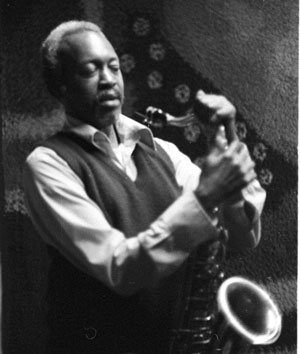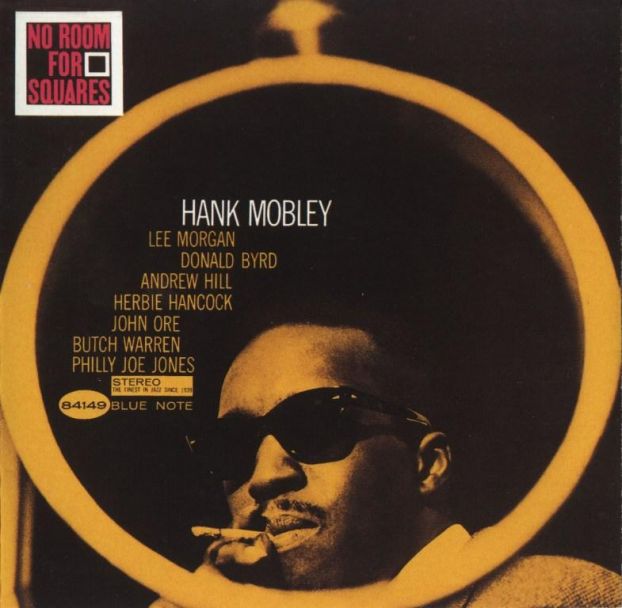Up A Step – Hank Mobley
This laid-back swing has a heavy cool jazz influence.
- Recording: Hank Mobley - No Room For Squares
- Recorded on: October 2, 1963
- Label: Blue Note (BLP 4149)
- Concert Key: D minor
- Vocal Range: , to
- Style: Swing (medium up)
- Tenor Sax - Hank Mobley
- Trumpet - Donald Byrd
- Piano - Herbie Hancock
- Bass - Butch Warren
- Drums - Philly Joe Jones
0:00
0:00
Buy MP3
- Description
- Historical Notes
- Solos
- Piano Corner
- Bass Corner
- Drum Corner
- Guitar Corner
- Inside & Beyond
- Minus You
Our audio excerpt starts where the horns enter in the intro. The eight measures of rhythm section intro that comes before the horn entrance is notated in the C treble clef lead sheet.
These lead sheets can be used for either a quartet or quintet. The recording is quintet. Hank played a harmony part in the intro and during most of the bridge. Donald Byrd on trumpet played the melody on the recording, and Hank's harmony notes are indicated under the melody. The harmony parts are written where they sound. In a quintet setting like the recording, a tenor sax would play these bottom notes an octave higher than they are written on the B-flat lead sheet. A trombonist wishing to play Hank's tenor sax harmony notes as they were recorded will have to play them up an octave.
These lead sheets can be used for either a quartet or quintet. The recording is quintet. Hank played a harmony part in the intro and during most of the bridge. Donald Byrd on trumpet played the melody on the recording, and Hank's harmony notes are indicated under the melody. The harmony parts are written where they sound. In a quintet setting like the recording, a tenor sax would play these bottom notes an octave higher than they are written on the B-flat lead sheet. A trombonist wishing to play Hank's tenor sax harmony notes as they were recorded will have to play them up an octave.
"No Room For Squares" was recorded at the legendary Van Gelder Studio in Englewood Cliffs.
On March 7 and October 2, 1963, Hank Mobley recorded two leader sessions for Blue Note. Blue Note's owner, Alfred Lion, would often assemble an LP out of material from more than one session. Hank's "No Room For Squares" LP was created from these two sessions. Two of Hank's compositions were labeled with the wrong titles on the LP "No Room For Squares." Up A Step is one of them. Hank named his composition Up A Step because the melody climbs up step by step. If you listen to the recording of Up A Step, you'll quickly realize that's not what the melody does. However, if you listen to the melody of No Room For Squares, you'll hear that is precisely what that melody does. So Hank's composition No Room For Squares is actually Up A Step and vice versa. For more history about this composition, see the Historical Notes for Hank's Gettin' And Jettin'.
On March 7 and October 2, 1963, Hank Mobley recorded two leader sessions for Blue Note. Blue Note's owner, Alfred Lion, would often assemble an LP out of material from more than one session. Hank's "No Room For Squares" LP was created from these two sessions. Two of Hank's compositions were labeled with the wrong titles on the LP "No Room For Squares." Up A Step is one of them. Hank named his composition Up A Step because the melody climbs up step by step. If you listen to the recording of Up A Step, you'll quickly realize that's not what the melody does. However, if you listen to the melody of No Room For Squares, you'll hear that is precisely what that melody does. So Hank's composition No Room For Squares is actually Up A Step and vice versa. For more history about this composition, see the Historical Notes for Hank's Gettin' And Jettin'.
Related Songs
Email Send Up A Step to a friend
Send this page to a friend via email. Add your name or email in the first field. In the second, add one or more email addresses, separated by a comma.

Hank Mobley
July 7, 1930 – May 30, 1986
Hank Mobley is one of the most acclaimed tenor saxophonists in modern jazz history. He is recognized by musicians and critics alike as one of the most important and eloquent jazz instrumentalists of all time. He recorded well over 100 of his own original compositions and left an indelible mark on the post-bop jazz scene. Read more...
There was a problem.
...



